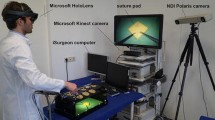Abstract
Purpose
To evaluate, in an experimental study, an interactive, computer-based teaching procedure for kinetic perimetry that incorporates an evaluation system for scoring examination technique.
Methods and subjects
K-Train was developed and based on the original user interface of the new semi-automated kinetic perimetry (SKP) feature of the OCTOPUS 101 perimeter (HAAG-STREIT, Koeniz, Switzerland). The trainer creates a 3D individual “hill of vision” for a specific pathology and the trainee can individually select target characteristics and independently define origin, end and direction of each kinetic stimulus with the help of vectors. Quality of the perimetric examination can be quantitatively assessed by the ratio of intersection area and union area of the trainee’s result and the related trainer-defined original isopter. This ratio and other parameters are used to define a score of “perimetric quality”. The general acceptance of K-Train was assessed in 30 participants in two perimetric courses. The success rate was examined by comparing the scores before and after a perimetric training session.
Results
The K-Train course was graded by the participants with an average score of 1.35 (range 1–3) in a scoring system ranging from 1=excellent to 6=unsatisfactory. The average perimetric quality score increased from 48 before to 59 (max. 100) after the training (27 trainees) indicating that K-Train was able to achieve and also verify a considerable success rate.
Conclusion
The acceptance of K-Train, a computer-based, interactive tool that allows for certification, education and quality control of kinetic perimetry, is high. K-Train is capable of improving a trainee’s individual performance in kinetic perimetry and of verifying this by an appropriate scoring system.








Similar content being viewed by others
References
Anderson DR (1982) Testing the field of vision. Mosby, St. Louis
Canadian Medical Association (1992) Physicians’ guide to driver examination. Canadian Medical Association, Ottawa
Egge K (1984) The visual field in normal subjects. Acta Ophthalmol Suppl 169:1–64
Ferree CE, Rand G, Monroe MM (1931) Diagnostic scales for the 1 degree and 0.17 degree form field stimuli for the eight principal meridional quadrants taken separately. Arch Ophthalmol 6:518–534
Goldmann H (1945) Grundlagen exakter Perimetrie. Ophthal 109:57–70
Goldmann H (1946) Demonstration unseres neuen Projektionskugelperimeters samt theoretischen und klinischen Bemerkungen über Perimetrie. Opthalmologica 11:187–192
Hulbert MFG (1992) Passing the DVLC field regulations following bilateral pan-retinal photocoagulation in diabetics. Eye 6:456–460
Johnson CA, Keltner JL (1987) Optimal rates of movement for kinetic perimetry. Arch Ophthalmol 105:73–75
Keltner JL, Johnson CA, Spurr JO, Beck RW (1999) Comparison of central and peripheral visual field properties in the Optic Neuritis Treatment Trial (ONTT). Am J Ophthalmol 128:543–553
Nowomiejska KE, Vonthein R, Krapp E, Rauscher S, Hermann A, Paetzold J, Schiefer U (2003) High resolution assessment of kinetic isopters on the stimulus size and luminance response surface. Invest Ophthalmol Vis Sci 44 (Suppl):E 1955
Paetzold J, Schiller J, Rauscher S, Schiefer U (2003) A computer application for training kinetic perimetry. In: Wall M, Mills RP (eds) Perimetry update 2002/2003. Kugler, The Hague, pp 69–73
Parisi JL, Bell RA, Yassein H (1991) Homonymous hemianoptic field defects and driving in Canada. Can J Optom 26:252–256
Parrish RK, Schiffman J, Anderson DR (1984) Static and kinetic visual field testing-reproducibility in normal volunteers. Arch Ophthalmol 102:1497–1502
Rauscher S, Vonthein R, Sadowski B, Erdmann B, Krapp E, Schiefer U (2002) Computer-assisted kinetic perimetry (CAKP) Using the Octopus 101 perimeter: age related normal values of local thresholds using various stimulus conditions and considering individual reaction times. Invest Ophthalmol Vis Sci 43 (12) (Suppl):3810
Schiefer U, Rauscher S, Hermann A, Nowomiejska KE, Sadowski B, Vonthein R, Paetzold J, Schiller J (2003) Age dependence of normative values in semi-automated kinetic perimetry (SKP) reviewing. Invest Ophthalmol Vis Sci 44 (Suppl):E-1957
Schiefer U, Rauscher S, Paetzold J, Schiller J (2003) Realization of semi-automated kinetic perimetry (SKP) with the Interzeag 101 instrument. In: Wall M, Mills RP (eds) Perimetry update 2002/2003. Kugler, The Hague, pp 233–238
Schiefer U, Schiller J, Dietrich TJ, Besch D, Paetzold J, Vonthein R (2001) Evaluation of advanced visual field loss with computer-assisted kinetic perimetry. In: Wall M, Mills RP (eds) Perimetry update 2000/2001. Kugler, The Hague, pp 131–136
Schiefer U, Schiller J, Paetzold J, Dietrich TJ, Vonthein R, Besch D (2001) Evaluation ausgedehnter Gesichtsfelddefekte mittels computerassistierter kinetischer Perimetrie. Klin Monatsbl Augenheilkd 218:13–20
Shapiro LR, Johnson CA (1990) Quantitative evaluation of manual kinetic perimetry using computer simulation. Applied Optics 29:1445–1450
Shapiro LR, Johnson CA (1991) Evaluation of the diagnosis of visual fields. Perimetry Update 281–285
Shapiro LR, Johnson CA, Kennedy RL (1989) KRAKEN. A computer simulation procedure for static, kinetic, suprathreshold static and heuristic perimetry. In: Heijl A (ed) Perimetry update 1988/89. Proceedings of the VIIIth International Perimetric Society Meeting. Kugler & Ghedini, Amsterdam
Verkehrskommission der DOG (2003) Empfehlung der Deutschen Ophthalmologischen Gesellschaft und des Berufsverbandes der Augenärzte Deutschlands zur Fahreignungsbegutachtung für den Straβenverkehr. BVA
Wabbels BK, Kolling G (1999) Automatische kinetische Perimetrie mit dem Twinfield-Perimeter. Z Prakt Augenheilkd 20:401–406
Wabbels BK, Kolling G (2001) Automatische kinetische Perimetrie mit unterschiedlichen Prüfgeschwindigkeiten. Ophthalmologe 98:168–173
Williams TD (1983) Computer-based analysis of visual fields: age-related norms for the central visual field. Can J Optom 45:166–170
Williams TD (1985) Age-related norms for the periphal visual field. Can J Optom 47:140–141
Williams TD (1997) Goldmann visual field norms for age groups 25 to 75 years: I-1, III-3 and III-4 targets. Can J Optom 58:170–175
Zehnder-Albrecht S (1950) Zur Standardisierung der Perimetrie. Ophthal 120:255–270
Author information
Authors and Affiliations
Corresponding author
Rights and permissions
About this article
Cite this article
Schiefer, U., Nowomiejska, K., Krapp, E. et al. K-Train–a computer-based, interactive training program with an incorporated certification system for practicing kinetic perimetry: evaluation of acceptance and success rate. Graefe's Arch Clin Exp Ophthalmo 244, 1300–1309 (2006). https://doi.org/10.1007/s00417-006-0291-9
Received:
Revised:
Accepted:
Published:
Issue Date:
DOI: https://doi.org/10.1007/s00417-006-0291-9




